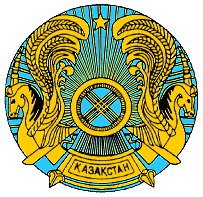
- Kasachstan
- Republik Kasachstan, Kazakstan Respublikasy
- Lage
- Zentralasien mit Russland im Norden, China im Osten, Kirgistan, Usbekistan und Turkmenistan im Süden sowie dem Kaspischen Meer im Westen. Kasachstan ist das zweitgrößte Mitgliedsland der Gemeinschaft Unabhängiger Staaten. 90% des Landes besteht aus Steppe, den Sandmassiven von Karakum und der weiten Wüste von Kisilkum. Im Südosten prägen die mächtigen Gebirge des Tienschan und des Alatau das Landschaftsbild, im Osten die Ausläufer des Altai-Gebirges. Der Aral-See und der Balchasch-See sind die größten Gewässer des Landes.
- Fläche
- gesamt: 2 717 300 qkm
- Land
- 2 669 800 qkm
- Wasser
- 47 500 qkm
- Landesgrenzen
- gesamt: 12 012 km
- Grenzstaaten
- China 1 533 km, Kirgisistan 1 051 km, Russland 6 846 km, Turkmenistan 379 km, Usbekistan 2 203 km

|
Daten des Statistischen Bundesamtes |
|||
| Bevölkerung | 16,1 | Mill. | 2001 |
| Fläche | 2717300 | qkm | 2001 |
| Bevölkerungsdichte | 6 | Einw. je qkm | 2001 |
| Arbeitslosenquote | n.v. | ||
| Bruttoinlandsprodukt (BIP) | 18230 | Mill.US-$ | 2000 |
| Jährliches BIP-Wachstum (real) | 9,6 | % | 2000 |
| BIP je Einwohner (real) | 1512 | US-$ | 2000 |
| Inflationsrate | 13,2 | % | 2000 |
| Importe | 5052 | Mill.US-$ | 2000 |
| Exporte | 9140 | Mill.US-$ | 2000 |
| Saldo der Im- und Exporte | 4087 | Mill.US-$ | 2000 |
| PKW-Dichte | 61 | je 1000 Einw. | 1999 |
| Personal-Computer | n.v. | ||
- Hauptstadt
- Astana (ca. 320 000 EW)
- Städte
- Alma Ata (ca. 1,1 Mio. EW), Karagandy, Shymkent, Pavlodar, Jambyl, Ust-Kamenogorsk, Uralsk, Temirtau, Kostanay, Aktobe, Petropavlovsk, Semipalatinsk (alle zw. 200 000 bis 400 000 EW)
- Staatsform
- Präsidialdemokratie. Das Parlament hat zwei Kammern, den Senat und den Mashilis mit 77 Abgeordneten. Der Senat setzt sich zusammen aus 2 Abgeordneten je Oblast und selbständiger Stadt, einem aus der Hauptstadt sowie sieben weiteren, vom Präsidenten benannten Mitgliedern.
- Verwaltungsstruktur
- 14 Gebiete (Oblaste); 3 administrativ selbständige Städte: Alma Ata, Akmola (Astana), Aqtobe, Astana, Atyrau, Batys Qazaqstan (Oral), Bayqongyr, Mangghystau (Shevchenko), Ongtustik Qazaqstan (Shymkent), Pavlodar, Qaraghandy, Qostanay, Qyzylorda, Shyghys Qazaqstan (Oskemen), Soltustik Qazaqstan (Petropavl), Zhambyl (Taraz)
- Klima
- Kontinentales Klima, sehr kalte Winter (Januarmittel -19° – -4°C) und heiße Sommer (Julimittel +19° – +26°C), geringe Niederschläge
- Landschaft
- 26% des Landes ist Steppe, 44 % Wüste und 14 % Halbwüste. Das Land ist geprägt von den Sandmassiven von Karakum und der weiten Wüste von Kisilkum. Im Südosten prägen die mächtigen Gebirge des Tienschan und des Alatau das Landschaftsbild, im Osten die Ausläufer des Altai-Gebirges. Der Aral-See und der Balchasch-See sind die größten Gewässer des Landes. der höchste Berg ist fast 7 000 m hoch. Die meisten Siedlungen sind im Südosten und Osten der Republik, wo sich die beeindruckenden Bergketten des Altai, Alatau und Tienschan befinden.



